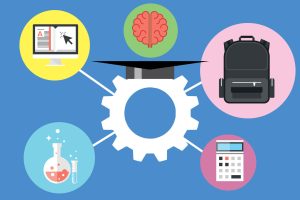Application Details
Prerequisites to Apply
Applicants to this master’s program must have a earned a four-year bachelor’s degree by the time of their matriculation. Earned minimum cumulative grade point average of 3.0 (on a 4.0 scale) in all previous undergraduate and graduate studies (including for incomplete programs of study and for programs still in progress).
Format
This program is delivered asynchronous online.
Application Requirements and Deadlines
| MEd in Learning Design and Technology | ||
|---|---|---|
| Application Deadline | July 15, 2026 | |
| Admissions Offer Response/Enrollment Deposit Deadline | $250 Enrollment deposits will be accepted on a rolling basis until the program reaches capacity or the start of classes for the first term. | |
| Application Requirements | Online application form | |
| $80.00 application fee | ||
| Resume/CV | ||
| Essay | To be uploaded to your online application form. A 500-word essay discussing why you wish to pursue a degree at Johns Hopkins University, focusing on your long-term goals and how your academic program will complement those goals. Discuss the strengths and weaknesses in your academic background and any additional comments that will assist in evaluating your application materials. Your statement should be typed, single-spaced, and one to two pages. | |
| Two Letters of Recommendation | Applicants are required to submit two recommendations using the online application system. After entering the contact information for two recommenders on your application, each will receive an email with instructions about logging onto our system. At that time, they will have the opportunity to fill out the Recommendation Form and upload a recommendation letter. Applicants should request recommendation letters that directly address their candidacy for admission to SOE and the MEd in Learning Design and Technology program. Ideally, individuals selected to provide letters should include those from both academic and professional settings. For candidates who have not been enrolled post-secondary level courses for many years, it is acceptable to substitute letters from professional contexts. | |
| Official transcripts from all post-secondary institutions attended. | ||
| GRE Admissions Test | The GRE is not required for admission to this program. | |
| Interview | While a structured interview is not required for admission, the Admissions Review Committee(s) may contact you to schedule a virtual interview to discuss your application. | |
Tuition and Fees
Tuition and fees are subject to change for ensuing academic years and will be updated on the School of Education website accordingly.
Financial Support Options
The Johns Hopkins School of Education offers a range of financial aid options, including grants, scholarships, federal loans, and work-study programs, to help you fund your education.
More Information
Baltimore, MD 21209
Suite M-500
What to Expect
Core Values and Pedagogical Approach
1. Learner-centered design
At the center of the LXD area of interest is the principle that sound pedagogy must guide design decisions, particularly in supporting learner agency. In line with the LDT program’s objective to apply theory and evidence to digital curriculum and environment design, students will explore how design decisions affect learners’ autonomy, engagement, and motivation, in addition to learning outcomes. This approach draws on constructivist theories, which emphasize that learning is most effective when learners are actively engaged in shaping their educational experiences. Students will integrate foundational instructional models and ideas, such as experiential learning and scaffolded instruction, into their designs, ensuring that learning is both practical and immersive.
The curriculum encourages the use of evidence-based strategies and digital tools to create learner-centered designs, while continuously putting ideas into practice through hands-on projects and assignments. By designing with empathy and attending to learner needs, students ensure that their designs are not only functional but also engaging and motivating. The emphasis on learner agency is not just theoretical. Students develop practical user experience research skills and apply them by designing learning prototypes using cutting-edge tools. This pragmatic approach ensures that students understand design principles and gain the technical expertise to bring their ideas to fruition.
2. Ethical responsibility and inclusivity
Commitment to equity and social justice in educational design is a core value of the area of interest. Students critically examine how their design choices affect diverse learners and strive for solutions that promote fairness, belongingness, and inclusivity, aligning with the LDT objective to assess technology’s sociocultural impact. Informed by critical pedagogy and social justice frameworks, students are also taught to develop learning environments that are responsive to the needs of diverse learners, ensuring that each design promotes equitable access to education. Courses emphasize ethical decision-making, challenging students to address the needs of marginalized populations through thoughtful and intentional design choices.
Pedagogical frameworks such as Universal Design for Learning (UDL) inform students’ design decisions, guiding them to create flexible learning environments that accommodate individual learning differences. By embedding pedagogy at the core of their design practices, students are better prepared to evaluate the sociocultural impact of their designs and to create educational solutions that are inclusive, accessible, and socially just. Students critically examine how their design choices affect learners from different backgrounds and work toward developing solutions that address educational inequities. This reflective process allows students to craft ethical, inclusive learning environments that go beyond addressing surface-level needs, fostering a deeper sense of belonging and engagement for all learners.
3. Interdisciplinary knowledge and evidence-based design
Pedagogical theory is integral to shaping the aesthetic principles applied in the LXD concentration. Rather than seeing aesthetics as separate from pedagogy, students will explore how the form and structure of a learning experience can support instructional goals. The concentration is grounded in an interdisciplinary framework, integrating insights from learning sciences, cognitive psychology, human-computer interaction, and design. By exploring multiple perspectives, students develop a deep understanding of how learners interact with technology and how design choices can influence learning outcomes. This approach reflects the LDT program’s objective to integrate evidence and ideas from learning sciences, motivation theories, and critical technology theory into designs. Further, students are guided to create learning experiences that are both practical and aesthetically rich. By integrating principles such as cohesion, immersion, and emotional resonance, students learn to create learning environments that are not only intellectually stimulating but also emotionally and experientially engaging.
Students will learn to blend aesthetics with pedagogy to create environments where learners are not only engaged intellectually but also emotionally and experientially. This integration ensures that designs are not only effective in achieving learning outcomes but also promote meaningful, lasting experiences that reflect pedagogical best practices. Students apply their understanding of user experience (UX) principles and research methods to design intuitive and effective learning environments. Empathy in design is emphasized, ensuring that user-centric solutions are both functional and engaging. The practical focus ensures that students continuously practice what they learn, refining their designs based on user feedback and data-driven insights.
4. Collaboration and leadership in learning design
Collaboration is essential to successful design, and the area of interest fosters this through team-based projects and real-world applications. In alignment with the LDT objective to collaborate and lead in educational technology solutions, students work closely with peers and diverse stakeholders throughout the program, developing technical competence and leadership skills. This prepares graduates to take on leadership roles in the design and implementation of educational technologies that meet the needs of specific environments.
The program encourages collaboration not just as a practical necessity but as a means of augmenting creativity and innovation. By working with others, students learn to integrate diverse perspectives, balancing technical, pedagogical, and aesthetic considerations to create comprehensive and effective learning solutions.
5. Reflection, Iteration, and Continuous Improvement
Reflection and iteration are central to pedagogy and design. Students learn to engage in reflective practice and to continuously assess and improve their work. Drawing on models of reflective practice, such as Schön’s reflective practitioner model, students engage in ongoing evaluation of their instructional designs, using feedback to refine their pedagogical strategies and ensure learner success. As part of the LDT program’s objective to use data to inform learning design and implementation evaluation, students are trained to use both qualitative and quantitative data to evaluate their designs, identify areas for improvement, and optimize learner outcomes. This process of reflection and iteration is woven into each course, ensuring that students develop the habits necessary for ongoing professional growth.
The iterative process fosters a mindset of continuous improvement, where learning is about achieving specific outcomes and about improving the design process itself. This reflective approach ensures that graduates can create high-quality learning environments and are prepared to adapt and evolve in response to emerging challenges.
Student Outcomes
Upon successful completion of the LDT program, graduates will demonstrate competence in six areas, preparing our learners for successful careers and pursuits in the field of educational technology.
- Theory and Evidence in the Design of Experiences and Solutions
Focusing on the integration of theoretical and empirical evidence from the learning sciences, media, and technology to design effective digital learning experiences and solutions. Learners will be able to:
- Describe and differentiate theories and ideas from the learning sciences, motivation, and media/technology.
- Use a variety of digital technologies to develop learning experiences or solutions for different learning environments and learners.
- Analyze and evaluate design options to identify appropriate and applicable theories and practices to accomplish intended instructional outcomes in a given context and for a learner population.
- Justify design and deployment decisions based on theory, ideas, models, or evidence.
- Design, develop, and deploy digital education solutions grounded in ideas and theories from the learning sciences, motivation, and media/technology.
- Ethical and Human-Centered Learning Solutions
Emphasizing the creation of learning solutions that are ethical, inclusive, and focused on the diverse needs of learners, adhering to best practices and industry standards. Learners will be able to:
- Identify and distinguish among diverse learner needs and incorporate these considerations into technology-supported learning experiences and solutions.
- Apply systematic models and systems thinking to create ethical, learner-focused digital tools and curricula.
- Evaluate learning solutions to ensure they advance equity and inclusivity across varied contexts.
- Design and develop accessible, inclusive, and flexible technology-supported learning experiences or solutions.
- Collaboration and Leadership in Educational Technology
Focusing on effective collaboration with stakeholders and leadership in the design, implementation, and evaluation of educational technology solutions. Learners will be able to:
- Collaborate with various involved and interested parties in a constructive, professional, and respectful way.
- Communicate shared visions for technology-supported solutions.
- Lead efforts to ensure the quality of technology-supported learning experiences.
- Lead ongoing evaluation efforts to continuously improve the selection and implementation of technologies and technology-based solutions.
- Collaborate and lead to develop evidence-based solutions to address instructional and/or programmatic needs using a variety of appropriate educational technologies and techniques.
- Communication Competence
Communicating design and pedagogical decisions effectively using various media and tailored to diverse audiences. Learners will be able to:
- Craft effective messages using appropriate media in written, verbal, and visual modalities.
- Articulate and justify pedagogical, design, and development decisions to diverse audiences.
- Communicate effectively with all invested parties to facilitate the design and development of learning products and solutions.
- Sociocultural Aspects of Educational Technology
Addressing the analysis of sociocultural factors, including power dynamics and privilege, and developing solutions to mitigate inequities in the design and deployment of educational technology and technology-supported solutions. Learners will be able to:
- Analyze how socioeconomic systems influence technology adoption and evaluation.
- Evaluate power dynamics and privilege affecting educational technology designs and implementations.
- Develop solutions to address and prevent injustices through educational technology designs and implementations.
- Design and develop equitable, inclusive, and accessible technology-supported systems, processes, and products.
- Data-Informed Learning Design, Implementation, and Evaluation
Using data to inform the design, development, and evaluation of learning experiences and technology-supported solutions, ensuring continuous improvement through evidence-based decision-making. Learners will be able to:
- Collect data using a variety of evaluation and research methods to gain insights into learner and educator needs and tool effectiveness.
- Use data to revise designs, practices, and goals based on evaluation data for continuous improvement.
- Analyze educational data using qualitative, quantitative, and mixed methods.
- Design and implement comprehensive data collection and analysis efforts to inform decisions concerning design, development, delivery, and evaluation of programs, processes, and/or products.
Learning Experience Design Area of Interest Course Descriptions
ED.XXX.XXX, LXD Area of Interest 1: Foundations and Applications of Learning Experience Design (3 cr.)
This course provides a comprehensive introduction to Learning Experience Design (LXD). Students will explore foundational design principles, learning theories, and user experience research methods, with a focus on adult learning environments. They will apply this knowledge in practical contexts, using tools such as Articulate Storyline 360, Adobe Illustrator, iSpring Suite, and front-end web development technologies (HTML, CSS, JavaScript) to create a technology-supported learning prototype. The hands-on approach ensures that students can synthesize theoretical knowledge with real-world application, preparing them for more advanced design challenges.
ED.XXX.XXX, LXD Area of Interest 2: Advanced User Experience and Interaction Design for Learning Environments (3 cr.)
This course offers an advanced exploration of user experience (UX) and interaction design in learning environments. Students will learn about usability, information architecture, and user research methodologies, applying these concepts to create intuitive and effective learning interfaces. The course emphasizes empathy in design, guiding students to craft user-centric solutions that align with clearly defined learning objectives and assessment strategies. (Prerequisite: LXD Concentration 1)
ED.XXX.XXX, LXD Area of Interest 3: Strategic Development, Evaluation, and Advanced Practices in Learning Experience Design (3 cr.)
In this capstone course, students immerse themselves in the strategic aspects of learning design. The course covers needs analysis, alignment of learning objectives with assessments, and the development of digital resources. Working in teams, students will apply instructional design models to create authentic learning solutions that address specific challenges. These team-based projects will ultimately serve as the foundation for students’ capstone projects, emphasizing collaboration, leadership, and adaptability in real-world contexts. (Prerequisite: LXD Concentration 1 and 2)
IMPORTANT QUESTIONS AND ANSWERS
What kinds of careers does the Learning Design and Technology program prepare me for?

The LDT program prepares you for careers at the intersection of learning, design, and technology.
Whether you're pursuing instructional design, learning experience design, AI in education, or leadership roles in K–12, higher ed, corporate, or nonprofit settings, you'll gain tools to design impactful learning and drive innovation. The flexible, real-world-focused program supports those looking to upskill or change careers.
Can I succeed in this program without a background in technology or design?

Absolutely. We welcome students from all professional backgrounds: teaching, curriculum development, counseling, training, and more.
Whether you're new to design tools or returning to school after time in the field, the program builds your technical confidence while leveraging your existing strengths. You'll graduate with a strong portfolio and the mindset needed to thrive in tech-enhanced learning environments.
Will I learn to use AI and other emerging technologies in the program?

Yes—and not just how to use them, but how to evaluate, implement, and lead with them.
The LDT program takes a critical, creative approach to tools like generative AI, learning analytics, and immersive platforms. You’ll explore how these tools can support deep learning, how to assess their ethical implications, and how to integrate them in ways that center equity, creativity, and learner agency.
How is the program structured to support working professionals?

The LDT program is fully online and built for flexibility, making it ideal for working professionals.
Courses are asynchronous with optional synchronous sessions for community and discussion. Assignments focus on real-world projects and collaborative learning, and faculty offer regular feedback and support. Whether you're balancing work, caregiving, or other commitments, we’ve built the program to fit into your life without sacrificing rigor or relevance.
Legal Disclosure
Master of Education in Learning Design and Technology
Students should be aware of additional state-specific information for online programs.